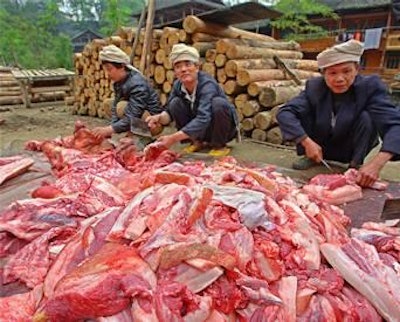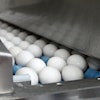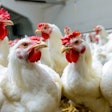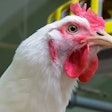
Global compound feed production is estimated at a bit less than 900 million metric tons, out of which more than 30 percent is in Asia. Pig feed represents 23 percent of the total animal feed volume, after poultry (44 percent) and ruminants (26 percent). More than half of the pigs produced worldwide today are raised in Asia, while a quarter of them are coming from Europe. In 2012, the top 5 pork meat producers were China (48 percent of the total), U.S., Germany, Spain, and Brazil.
Latin America
In South America, the major producer is Brazil, which enjoyed an 18 percent production increase from 2002 to 2012. In recent years, the main changes observed were a consolidation accompanied by integration. In 2012, 61 percent of producers were integrated. It is estimated that about 85 percent of pigs come from intensive farms, whereas only 15 percent are raised in backyard farms. Intensive units are the most efficient, since they hold 70 percent of the total national herd of sows. The number of backyard farm is decreasing. Luciano Roppa reported that, for instance, in Santa Catarina state, in 1985, there were 54,200 pig farms for a total of 3,200,000 animals (59 pigs per farm). In 2011, the number of production units had dropped by almost 80 percent (12,000) while there were, on average, 516 pigs per farm, an increase of almost 800 percent.
North America
In Canada and the U.S., the number of farms was also drastically reduced over the last few years while remaining units grew bigger. Since 2000, the number of pig farms has been reduced by more than 70 percent. In the U.S., in 2009, 50 percent of farms represented 0.9 percent of the total inventory, while 0.13 percent of farms held 57 percent of the pigs. Large farms specialized in a single phase of production have replaced farrow-to-finish operations, and contract farming has increased. Like in Brazil, due to increases in the scale of production and technological innovation, gains in efficiency and lower production costs are being observed. Since 2013, the major concern in the U.S. has been the outbreak of porcine epidemic diarrhea virus (PEDV). As of January 20th, 2014, a total of 2,271 confirmed cases were reported in 23 states, and, according to some industry sources, this could result in a loss of two to three million pigs, or up to 3 percent of total slaughter.
Europe
In Europe, sow inventory has decreased by more than 3.8 million animals (23.5 percent) in the last 10 years because of competition and costly regulations related to environment and animal welfare. However, total meat production in the EU has not been affected from this fall in sows' numbers, and, again, the average number of sows per farm increased in almost every country. For example, in Denmark, the number of sows per farm increased by 40 percent between 2002 and 2011. During the same period, the number of farms has dropped by almost 50 percent, while the number of pigs produced per sow per year was improved by about 20 percent. Since January 1, 2013, the new animal welfare regulations for sows, combined with high feed prices, have forced more farmers to stop production. The sow population has been reduced by 4.2 percent, with the major drop observed in Spain, Poland, Germany and Italy.
Asia
In Asia, the rate of growth in production depends on how fast commercial-scale units are able to replace the stock of pigs from disappearing backyard producers. In 2012, these smaller farms represented approximately 40 percent of the pigs slaughtered in China, 64 percent in the Philippines, and 85 to 90 percent in Vietnam. In the Philippine archipelago, the share of commercial farms has increased from 19 percent in 1994 to 36 percent in 2013. In China, even more drastic changes were observed. In 1983, backyard farms produced 94 percent of the pigs slaughtered.
Their contribution dropped to 73 percent in 1998, and now they represent less than 40 percent of the total volume.
Of particular interest is the situation in Thailand and Vietnam, two neighbors in contrast. In Thailand, it is estimated that integrated and contract farms represent 40 percent of the total production, while they comprise only about 7 percent in Vietnam. About half of pigs are raised in commercial farms in Thailand, a figure that drops to about 5 percent for Vietnam. As a consequence, only 5 to 10 percent of pigs come from backyard farms (less than 100 sows) in the former Siam, while in Vietnam where a backyard farm has less than 50 sows, this number is close to 90 percent. Defining average performance in Vietnam is a huge challenge, due to the big differences between large farms and backyard units. For instance, the number of piglets weaned per sow per year is usually between 10 and 15 in small farms, but increases to more than 20 (21 to 22) in larger operations. The average weight at slaughter can be as low as 40 to 60 kg for backyard but increases to 110 kg for the commercial units. As a result, the number of kg of meat produced per sow per year is more than double when comparing small and large pig farms.
Due to the fact that official figures are not available in many countries, it is extremely difficult to compare productivity from one nation to another. In Table 1, we tried to summarize the usual performances obtained by large units across the globe.
The future
What about the future? According to recent reports, global human population will grow to 9 billion by 2050, and the Food and Agriculture Organization of the United Nations (FAO) estimates the world will have to produce about 60 to 70 percent more food in the next 35 years, while the Organisation for Economic Co-operation and Development (OECD) states that the world will need 20 percent more food by 2020. According to the FAO, animal protein production will grow at least 3 times by 2050, and meats (poultry, swine, and beef) will double while fish production will be multiplied by almost 10 times. An increase in intensification is inevitable, because arable land cannot be increased in proportion. The key challenge will be to produce sustainable food and, of course, sustainable feed to raise our animals, with limited availability of resources and with the need to reduce pressure on the environment.
The main challenge for swine producers will be "to do more with less." They will need to cope with higher feed costs, more pressure from legislation and, at the same time, more expectations from consumers. Improving feed efficiency will be the key for success, and for this we need to remember the basics. For instance, we have to keep in mind that healthy pigs will grow better and that a low mortality means less feed lost. Farmers will also need to look for optimal slaughter weights, as FCR increases with weight. They can also increase their profitability by improving their feeding techniques and feeding programs by delivering feeds appropriate to pig weight. As far as feed formulation is concerned, we must continue to look for optimal combination of proteins, energy, and other nutrients, depending on growth stage. The proper use of synthetic amino acids and other feed additives will be also required to improve the performance of our swine farms across the globe.


















